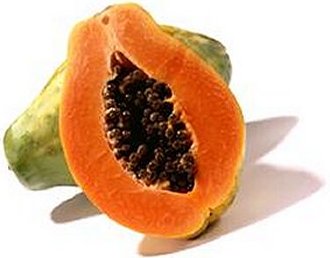Sandbox 31
From Proteopedia
| Line 23: | Line 23: | ||
Papain is formed from a peptide that is 212 amino acids in length. It consists of 25% <scene name='Sandbox_31/Alpha_helices/4'>Alpha helices</scene> and 21% <scene name='Sandbox_31/Beta_sheet/2'>Beta Sheet</scene>. The structure also consists of three <scene name='Sandbox_31/Disulfide/3'>Disulfide bonds</scene> between <scene name='Sandbox_31/Cys_with_labels/2'>Cysteine Residues</scene>. The disulfide bonds exist between Cys 63 and Cys 22, Cys 200 and Cys 153, and Cys 56 and Cys 95. Another important residue to the structure is Cysteine 25 which has a sulfhydryl group that plays a major role in the active site activity[[http://www.sigmaaldrich.com/life-science/metabolomics/enzyme-explorer/analytical-enzymes/papain.html]]. | Papain is formed from a peptide that is 212 amino acids in length. It consists of 25% <scene name='Sandbox_31/Alpha_helices/4'>Alpha helices</scene> and 21% <scene name='Sandbox_31/Beta_sheet/2'>Beta Sheet</scene>. The structure also consists of three <scene name='Sandbox_31/Disulfide/3'>Disulfide bonds</scene> between <scene name='Sandbox_31/Cys_with_labels/2'>Cysteine Residues</scene>. The disulfide bonds exist between Cys 63 and Cys 22, Cys 200 and Cys 153, and Cys 56 and Cys 95. Another important residue to the structure is Cysteine 25 which has a sulfhydryl group that plays a major role in the active site activity[[http://www.sigmaaldrich.com/life-science/metabolomics/enzyme-explorer/analytical-enzymes/papain.html]]. | ||
| - | The <scene name='Sandbox_31/Hydrophobic_residues/2'>Hydrophobic Residues</scene> in papain are primarily located toward the inside of the enzyme or paired by hydrophobic interactions with other hydrophobic residues to exclude water. The <scene name='Sandbox_31/Charged/2'>Polar Residues</scene> are located facing the exterior, in the active site, or paired with other charged residues. The <scene name='Sandbox_31/Positive/1'>Negatively</scene> charged residues (acidic) and the <scene name='Sandbox_31/Basic_positive/1'> | + | The <scene name='Sandbox_31/Hydrophobic_residues/2'>Hydrophobic Residues</scene> in papain are primarily located toward the inside of the enzyme or paired by hydrophobic interactions with other hydrophobic residues to exclude water. The <scene name='Sandbox_31/Charged/2'>Polar Residues</scene> are located facing the exterior, in the active site, or paired with other charged residues. The <scene name='Sandbox_31/Positive/1'>Negatively</scene> charged residues (acidic) and the <scene name='Sandbox_31/Basic_positive/1'>Positively</scene> charged residues (basic) make up the polar residues. The charged and polar residues are hydrophilic therefore do not orient themselves to exclude water or solvent. The charged <scene name='Sandbox_31/Termini/4'>Termini</scene> face outward due to their hydrophilic nature. |
Revision as of 17:54, 14 November 2011
>
| Please do NOT make changes to this Sandbox. Sandboxes 30-60 are reserved for use by Biochemistry 410 & 412 at Messiah College taught by Dr. Hannah Tims during Fall 2012 and Spring 2013. |
Papain (PDB ID #: 9pap)
| |||||||||||
Active Site and Mechanism
The active site of papain has a including CYS 25, HIS 159, and ASN 175.
(Active Site of Papain) Image:Papain2.jpg
This triad interacts with the substrate to catalyze the reaction. The sulfhydryl group on CYS 25 plays the key role in the mechanism, which is why papain is considered a thiol protease. The sulfur from CYS 25 attacks the backbone amine on the substrate forming a tetrahedral intermediate. Next, the carbonyl is reformed and the carbon nitrogen bond is broken. A water associated with a nitrogen on HIS 159 then attacks the carbonyl forming a second tetrahedral intermediate. The carbonyl then reforms breaking the carbon-sulfur bond. This leaves a carboxy group on the end of one piece of the substrate and an amino group on the end of the other piece.
(Mechanism of the Papain Enzyme with substrate) Image:Mech.jpg
References
http://dailyfitnessmagz.com/2011/03/papayas-nutrition-facts/ http://www.sigmaaldrich.com/life-science/metabolomics/enzyme-explorer/analytical-enzymes/papain.html http://peds.oxfordjournals.org/content/7/1/75.abstract http://www.pdb.org/pdb/explore/remediatedSequence.do?structureId=9PAP http://faculty.csusm.edu/lcohen/index.html

